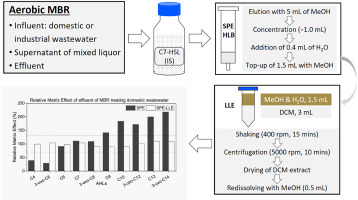当前位置:
X-MOL 学术
›
Water Res.
›
论文详情
Our official English website, www.x-mol.net, welcomes your feedback! (Note: you will need to create a separate account there.)
Analysis of N-Acy-L-homoserine lactones (AHLs) in wastewater treatment systems using SPE-LLE with LC-MS/MS.
Water Research ( IF 12.8 ) Pub Date : 2020-04-01 , DOI: 10.1016/j.watres.2020.115756 Shujuan Huang 1 , Hui Zhang 2 , Tze Chiang Albert Ng 1 , Boyan Xu 1 , Xueqing Shi 3 , How Yong Ng 4
Water Research ( IF 12.8 ) Pub Date : 2020-04-01 , DOI: 10.1016/j.watres.2020.115756 Shujuan Huang 1 , Hui Zhang 2 , Tze Chiang Albert Ng 1 , Boyan Xu 1 , Xueqing Shi 3 , How Yong Ng 4
Affiliation

|
The occurrence and distribution of N-acyl homoserine lactones (AHLs) in membrane bioreactors (MBRs) treating wastewater has garnered much attention as they have been shown to play critical role in biofouling. There is a need to develop a single method capable of analysing AHLs in various wastewater with comparable and reliable performance. A novel and robust method was proposed for trace analysis of 11 AHLs in wastewater treatment systems treating domestic and industrial wastewater. This method utilised solid phase extraction (SPE) to extract AHLs from wastewater followed by liquid-liquid extraction (LLE) to extract AHLs from the SPE eluant, and used N-heptanoyl-dl-homoserine lactone (C7-HSL) as an internal standard. There was no need to prepare matrix-matched calibration curve for accurate quantification of AHLs in the liquid chromatography tandem mass chromatography (LC-MS/MS) analysis. The developed method was validated with six different types of domestic and industrial wastewater with regard to AHLs recoveries and matrix effects. For treated domestic and industrial wastewater, the relative recoveries ranged from 75% to 130% and the matrix effects ranged from 89% to 122%. This method exhibited remarkable improvement compared with single SPE. The results also indicated that inclusion of LLE after SPE could effectively alleviate matrix effects, which may be because of the removal of relatively hydrophilic interferences by using dichloromethane to extract AHLs from the SPE eluant composing of methanol and water. The limits of detection of the AHLs were all below 5 ng/L for the tested wastewater samples. The developed method of SPE-LLE with LC-MS/MS was applied to analyse AHLs in four lab-scale and one pilot-scale wastewater treatment systems. Wide spectrum of AHLs with alkanoyl chains ranging from C4 to C14 were detected with concentrations ranging from 2.7 to 299.2 ng/L. This method is capable of identifying and quantifying trace levels of AHLs in various wastewater treatment systems and can help us better understand the mechanisms of AHL-mediated quroum sensing in various wastewater treatment systems.
中文翻译:

使用SPE-LLE和LC-MS / MS分析废水处理系统中的N-Acy-L-高丝氨酸内酯(AHL)。
N-酰基高丝氨酸内酯(AHLs)在膜生物反应器(MBRs)处理废水中的发生和分布已引起了广泛关注,因为它们已显示在生物污染中起关键作用。需要开发一种能够以可比的和可靠的性能分析各种废水中的AHL的单一方法。提出了一种新颖而强大的方法,用于处理生活和工业废水的废水处理系统中的11种AHL的痕量分析。该方法利用固相萃取(SPE)从废水中萃取AHL,然后液-液萃取(LLE)从SPE洗脱液中萃取AHL,并使用N-庚酰基-dl-高丝氨酸内酯(C7-HSL)作为内标。在液相色谱串联质谱(LC-MS / MS)分析中,无需准备基质匹配的校准曲线即可准确定量AHL。关于AHL的回收率和基质效应,该方法已用六种不同类型的生活和工业废水进行了验证。对于处理后的生活和工业废水,相对回收率介于75%至130%之间,基质效应介于89%至122%之间。与单SPE相比,该方法显示出显着的改进。结果还表明,在SPE之后加入LLE可以有效地减轻基质效应,这可能是由于使用二氯甲烷从由甲醇和水组成的SPE洗脱液中提取了相对亲水的干扰而消除的。对于所测试的废水样品,AHL的检出限均低于5 ng / L。采用LC-MS / MS开发的SPE-LLE方法被用于分析四个实验室规模和一个中试规模的废水处理系统中的AHL。检测到链烷酰基链为C4至C14的宽广AHL,其浓度范围为2.7至299.2 ng / L。该方法能够识别和量化各种废水处理系统中AHL的痕量水平,并且可以帮助我们更好地了解各种废水处理系统中AHL介导的Qumum感测的机制。检测到链烷酰基链为C4至C14的宽广AHL,其浓度范围为2.7至299.2 ng / L。该方法能够识别和量化各种废水处理系统中AHL的痕量水平,并且可以帮助我们更好地了解各种废水处理系统中AHL介导的Qumum感测的机制。检测到链烷酰基链为C4至C14的宽广AHL,其浓度范围为2.7至299.2 ng / L。该方法能够识别和量化各种废水处理系统中AHL的痕量水平,并且可以帮助我们更好地了解各种废水处理系统中AHL介导的Qumum感测的机制。
更新日期:2020-04-03
中文翻译:

使用SPE-LLE和LC-MS / MS分析废水处理系统中的N-Acy-L-高丝氨酸内酯(AHL)。
N-酰基高丝氨酸内酯(AHLs)在膜生物反应器(MBRs)处理废水中的发生和分布已引起了广泛关注,因为它们已显示在生物污染中起关键作用。需要开发一种能够以可比的和可靠的性能分析各种废水中的AHL的单一方法。提出了一种新颖而强大的方法,用于处理生活和工业废水的废水处理系统中的11种AHL的痕量分析。该方法利用固相萃取(SPE)从废水中萃取AHL,然后液-液萃取(LLE)从SPE洗脱液中萃取AHL,并使用N-庚酰基-dl-高丝氨酸内酯(C7-HSL)作为内标。在液相色谱串联质谱(LC-MS / MS)分析中,无需准备基质匹配的校准曲线即可准确定量AHL。关于AHL的回收率和基质效应,该方法已用六种不同类型的生活和工业废水进行了验证。对于处理后的生活和工业废水,相对回收率介于75%至130%之间,基质效应介于89%至122%之间。与单SPE相比,该方法显示出显着的改进。结果还表明,在SPE之后加入LLE可以有效地减轻基质效应,这可能是由于使用二氯甲烷从由甲醇和水组成的SPE洗脱液中提取了相对亲水的干扰而消除的。对于所测试的废水样品,AHL的检出限均低于5 ng / L。采用LC-MS / MS开发的SPE-LLE方法被用于分析四个实验室规模和一个中试规模的废水处理系统中的AHL。检测到链烷酰基链为C4至C14的宽广AHL,其浓度范围为2.7至299.2 ng / L。该方法能够识别和量化各种废水处理系统中AHL的痕量水平,并且可以帮助我们更好地了解各种废水处理系统中AHL介导的Qumum感测的机制。检测到链烷酰基链为C4至C14的宽广AHL,其浓度范围为2.7至299.2 ng / L。该方法能够识别和量化各种废水处理系统中AHL的痕量水平,并且可以帮助我们更好地了解各种废水处理系统中AHL介导的Qumum感测的机制。检测到链烷酰基链为C4至C14的宽广AHL,其浓度范围为2.7至299.2 ng / L。该方法能够识别和量化各种废水处理系统中AHL的痕量水平,并且可以帮助我们更好地了解各种废水处理系统中AHL介导的Qumum感测的机制。



























 京公网安备 11010802027423号
京公网安备 11010802027423号